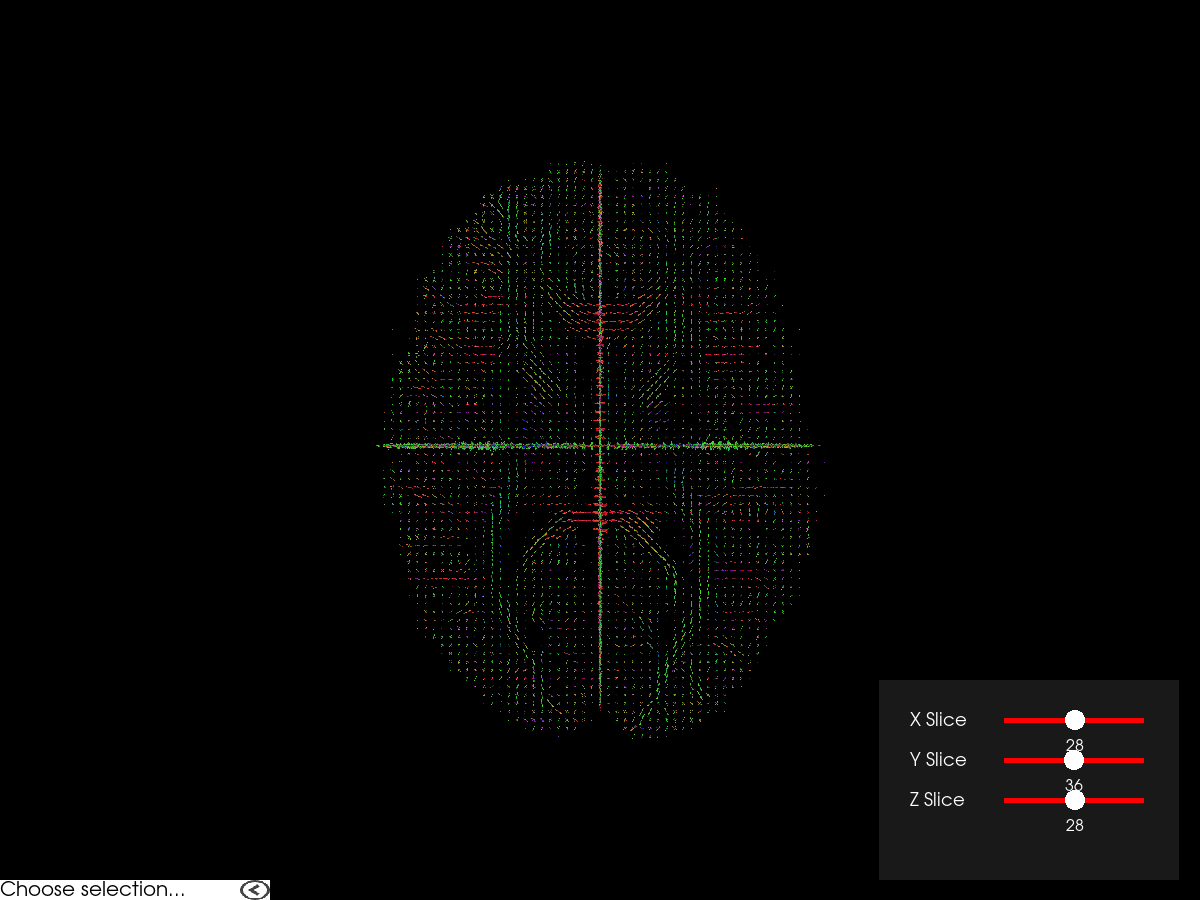Note
Go to the end to download the full example code
Brain Fiber ODF Visualisation#
This example demonstrate how to create a simple viewer for fiber orientation distribution functions (ODF) using fury’s odf_slicer.
from dipy.data import get_sphere
from dipy.reconst.shm import sh_to_sf_matrix
import nibabel as nib
# First, we import some useful modules and methods.
import numpy as np
import fury
Here, we fetch and load the fiber ODF volume to display. The ODF are expressed as spherical harmonics (SH) coefficients in a 3D grid.
fury.data.fetch_viz_dmri()
fury.data.fetch_viz_icons()
fodf_img = nib.load(fury.data.read_viz_dmri("fodf.nii.gz"))
sh = fodf_img.get_fdata()
affine = fodf_img.affine
grid_shape = sh.shape[:-1]
Dataset is already in place. If you want to fetch it again please first remove the folder /Users/skoudoro/.fury/dmri
Data size is approximately 12KB
Dataset is already in place. If you want to fetch it again please first remove the folder /Users/skoudoro/.fury/icons
We then define a low resolution sphere used to visualize SH coefficients as spherical functions (SF) as well as a matrix B_low to project SH onto the sphere.
sphere_low = get_sphere("repulsion100")
B_low = sh_to_sf_matrix(sphere_low, 8, return_inv=False)
Now, we create a slicer for each orientation to display a slice in the middle of the volume and we add them to a scene.
# Change these values to test various parameters combinations.
scale = 0.5
norm = False
colormap = None
radial_scale = True
opacity = 1.0
global_cm = False
# ODF slicer for axial slice
odf_actor_z = fury.actor.odf_slicer(
sh,
affine=affine,
sphere=sphere_low,
scale=scale,
norm=norm,
radial_scale=radial_scale,
opacity=opacity,
colormap=colormap,
global_cm=global_cm,
B_matrix=B_low,
)
# ODF slicer for coronal slice
odf_actor_y = fury.actor.odf_slicer(
sh,
affine=affine,
sphere=sphere_low,
scale=scale,
norm=norm,
radial_scale=radial_scale,
opacity=opacity,
colormap=colormap,
global_cm=global_cm,
B_matrix=B_low,
)
odf_actor_y.display_extent(
0, grid_shape[0] - 1, grid_shape[1] // 2, grid_shape[1] // 2, 0, grid_shape[2] - 1
)
# ODF slicer for sagittal slice
odf_actor_x = fury.actor.odf_slicer(
sh,
affine=affine,
sphere=sphere_low,
scale=scale,
norm=norm,
radial_scale=radial_scale,
opacity=opacity,
colormap=colormap,
global_cm=global_cm,
B_matrix=B_low,
)
odf_actor_x.display_extent(
grid_shape[0] // 2, grid_shape[0] // 2, 0, grid_shape[1] - 1, 0, grid_shape[2] - 1
)
scene = fury.window.Scene()
scene.add(odf_actor_z)
scene.add(odf_actor_y)
scene.add(odf_actor_x)
show_m = fury.window.ShowManager(scene, reset_camera=True, size=(1200, 900))
/opt/homebrew/Caskroom/miniforge/base/envs/py311-fury/lib/python3.11/site-packages/sphinx_gallery/gen_rst.py:722: UserWarning: We'll no longer accept the way you call the __init__ function in future versions of FURY.
Here's how to call the Function __init__: __init__(self_value, scene='value', title='value', size='value', png_magnify='value', reset_camera='value', order_transparent='value', interactor_style='value', stereo='value', multi_samples='value', max_peels='value', occlusion_ratio='value')
exec(self.code, self.fake_main.__dict__)
Now that we have a ShowManager containing our slicer, we can go on and configure our UI for changing the slices to visualize.
line_slider_z = fury.ui.LineSlider2D(
min_value=0,
max_value=grid_shape[2] - 1,
initial_value=grid_shape[2] / 2,
text_template="{value:.0f}",
length=140,
)
line_slider_y = fury.ui.LineSlider2D(
min_value=0,
max_value=grid_shape[1] - 1,
initial_value=grid_shape[1] / 2,
text_template="{value:.0f}",
length=140,
)
line_slider_x = fury.ui.LineSlider2D(
min_value=0,
max_value=grid_shape[0] - 1,
initial_value=grid_shape[0] / 2,
text_template="{value:.0f}",
length=140,
)
We also define a high resolution sphere to demonstrate the capability to dynamically change the sphere used for SH to SF projection.
sphere_high = get_sphere("symmetric362")
# We fix the order of the faces' three vertices to a clockwise winding. This
# ensures all faces have a normal going away from the center of the sphere.
sphere_high.faces = fury.utils.fix_winding_order(
sphere_high.vertices, sphere_high.faces, True
)
B_high = sh_to_sf_matrix(sphere_high, 8, return_inv=False)
/opt/homebrew/Caskroom/miniforge/base/envs/py311-fury/lib/python3.11/site-packages/sphinx_gallery/gen_rst.py:722: UserWarning: We'll no longer accept the way you call the fix_winding_order function in future versions of FURY.
Here's how to call the Function fix_winding_order: fix_winding_order(vertices_value, triangles_value, clockwise='value')
exec(self.code, self.fake_main.__dict__)
We add a combobox for choosing the sphere resolution during execution.
sphere_dict = {
"Low resolution": (sphere_low, B_low),
"High resolution": (sphere_high, B_high),
}
combobox = fury.ui.ComboBox2D(items=list(sphere_dict))
scene.add(combobox)
Here we will write callbacks for the sliders and combo box and register them.
def change_slice_z(slider):
i = int(np.round(slider.value))
odf_actor_z.slice_along_axis(i)
def change_slice_y(slider):
i = int(np.round(slider.value))
odf_actor_y.slice_along_axis(i, "yaxis")
def change_slice_x(slider):
i = int(np.round(slider.value))
odf_actor_x.slice_along_axis(i, "xaxis")
def change_sphere(combobox):
sphere, B = sphere_dict[combobox.selected_text]
odf_actor_x.update_sphere(sphere.vertices, sphere.faces, B)
odf_actor_y.update_sphere(sphere.vertices, sphere.faces, B)
odf_actor_z.update_sphere(sphere.vertices, sphere.faces, B)
line_slider_z.on_change = change_slice_z
line_slider_y.on_change = change_slice_y
line_slider_x.on_change = change_slice_x
combobox.on_change = change_sphere
We then add labels for the sliders and position them inside a panel.
def build_label(text):
label = fury.ui.TextBlock2D()
label.message = text
label.font_size = 18
label.font_family = "Arial"
label.justification = "left"
label.bold = False
label.italic = False
label.shadow = False
label.background_color = (0, 0, 0)
label.color = (1, 1, 1)
return label
line_slider_label_z = build_label(text="Z Slice")
line_slider_label_y = build_label(text="Y Slice")
line_slider_label_x = build_label(text="X Slice")
panel = fury.ui.Panel2D(size=(300, 200), color=(1, 1, 1), opacity=0.1, align="right")
panel.center = (1030, 120)
panel.add_element(line_slider_label_x, (0.1, 0.75))
panel.add_element(line_slider_x, (0.38, 0.75))
panel.add_element(line_slider_label_y, (0.1, 0.55))
panel.add_element(line_slider_y, (0.38, 0.55))
panel.add_element(line_slider_label_z, (0.1, 0.35))
panel.add_element(line_slider_z, (0.38, 0.35))
show_m.scene.add(panel)
Then, we can render all the widgets and everything else in the screen and
start the interaction using show_m.start().
However, if you change the window size, the panel will not update its
position properly. The solution to this issue is to update the position of
the panel using its re_align method every time the window size changes.
Finally, please set the following variable to True to interact with the
datasets in 3D.
interactive = False
if interactive:
show_m.add_window_callback(win_callback)
show_m.render()
show_m.start()
else:
fury.window.record(
scene, out_path="odf_slicer_3D.png", size=(1200, 900), reset_camera=False
)
del show_m

/opt/homebrew/Caskroom/miniforge/base/envs/py311-fury/lib/python3.11/site-packages/sphinx_gallery/gen_rst.py:722: UserWarning: We'll no longer accept the way you call the record function in future versions of FURY.
Here's how to call the Function record: record(scene='value', cam_pos='value', cam_focal='value', cam_view='value', out_path='value', path_numbering='value', n_frames='value', az_ang='value', magnification='value', size='value', reset_camera='value', screen_clip='value', stereo='value', verbose='value')
exec(self.code, self.fake_main.__dict__)
Total running time of the script: (0 minutes 1.697 seconds)
